UGB 260: Reflective Essay of Personal and Professional Development
VerifiedAdded on 2023/01/05
|12
|4967
|1
Essay
AI Summary
This reflective essay, written by a student, examines the author's personal and professional development needs, specifically focusing on communication skills and self-confidence in a nursing context. The essay utilizes Gibbs' reflective model to analyze a challenging clinical experience involving a patient named Tommy and identifies the need to improve communication, particularly assertiveness, to enhance patient care and avoid potential errors. The author draws upon various research studies to support their reflections, highlighting the importance of confidence, effective communication, and patient-centered care. The essay also discusses the impact of mentorship, the importance of evidence-based practice, and the implications for future practice. The author reflects on their learning needs and the strategies employed to address them, concluding with the importance of continuous learning and development in the nursing profession.
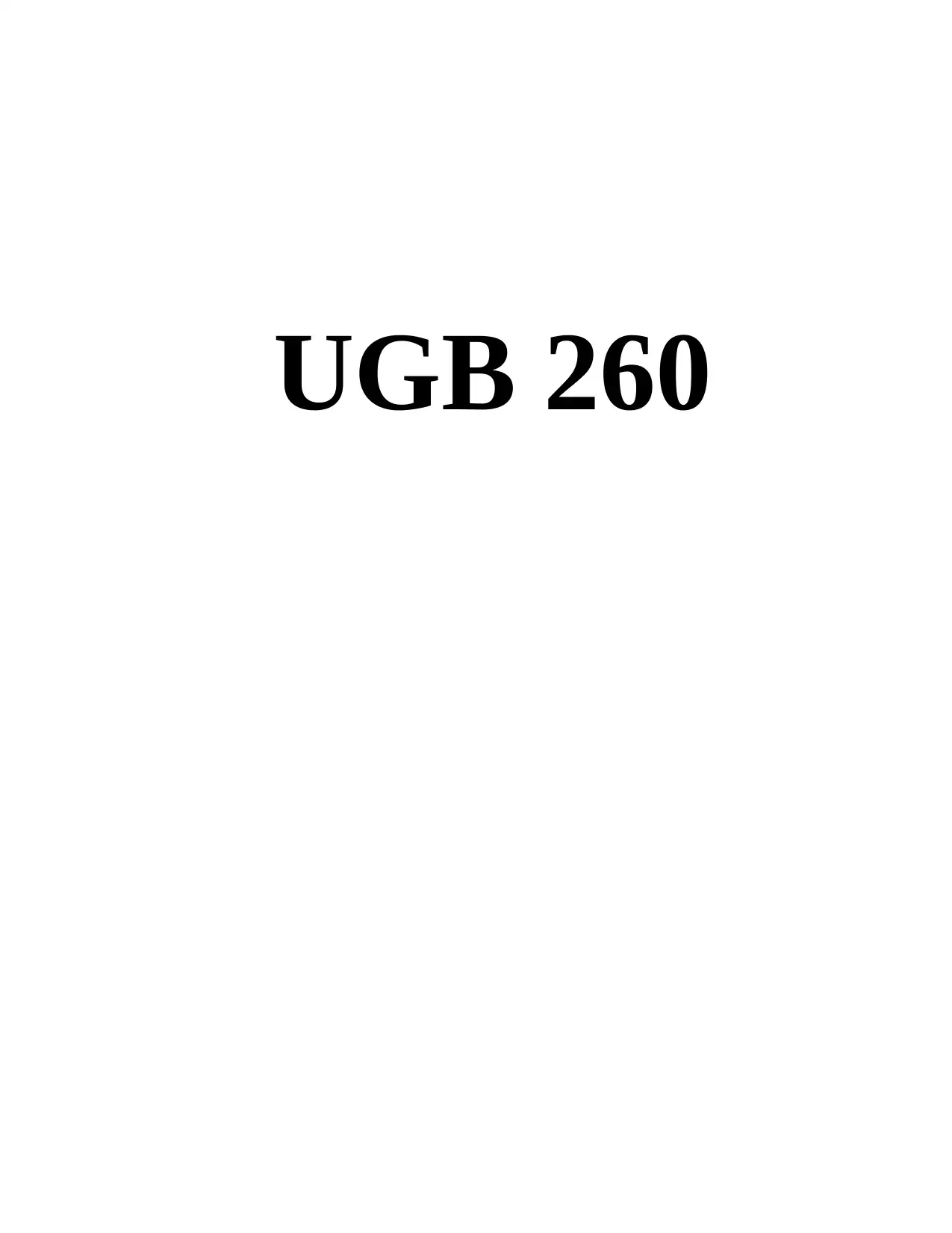
UGB 260
Paraphrase This Document
Need a fresh take? Get an instant paraphrase of this document with our AI Paraphraser
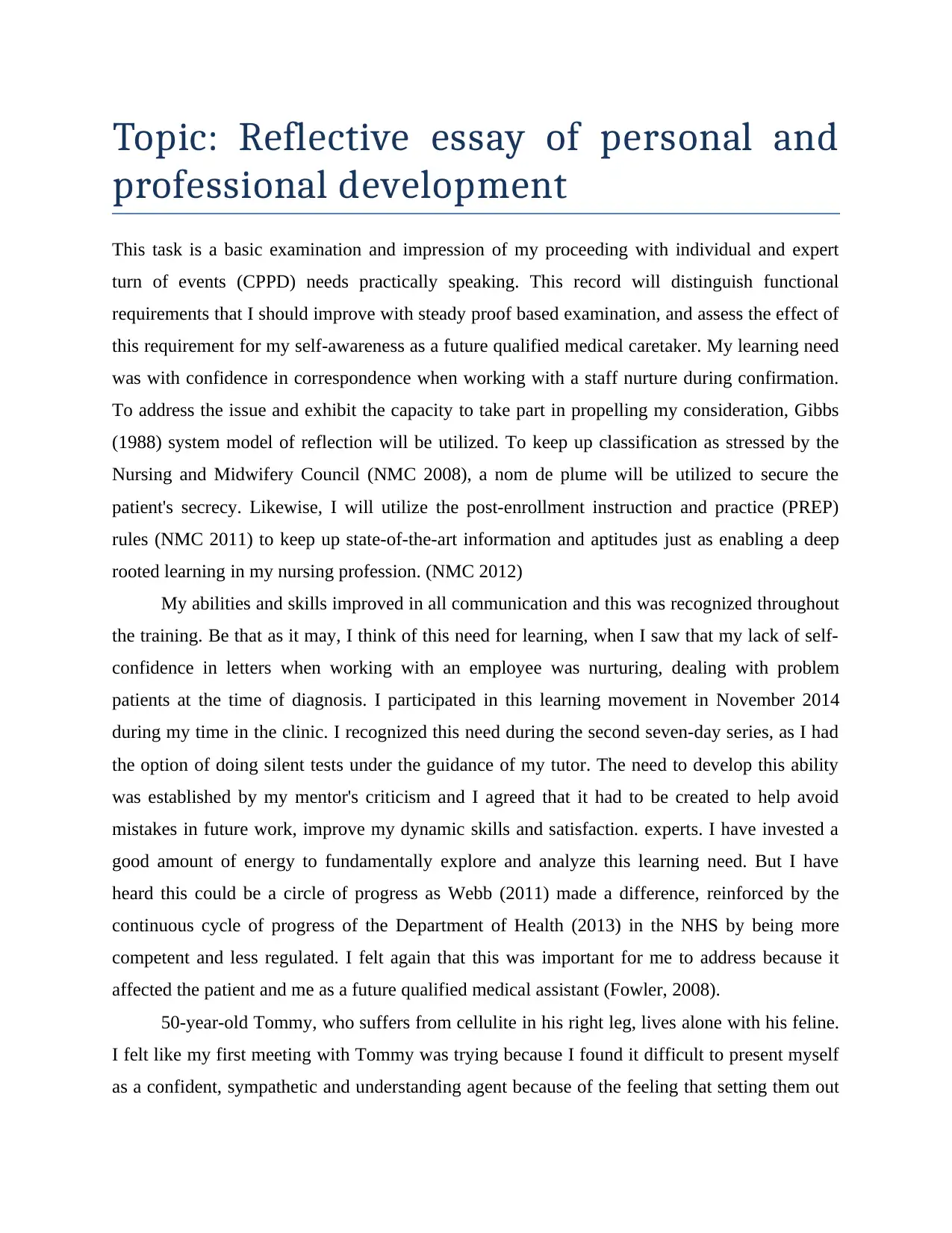
Topic: Reflective essay of personal and
professional development
This task is a basic examination and impression of my proceeding with individual and expert
turn of events (CPPD) needs practically speaking. This record will distinguish functional
requirements that I should improve with steady proof based examination, and assess the effect of
this requirement for my self-awareness as a future qualified medical caretaker. My learning need
was with confidence in correspondence when working with a staff nurture during confirmation.
To address the issue and exhibit the capacity to take part in propelling my consideration, Gibbs
(1988) system model of reflection will be utilized. To keep up classification as stressed by the
Nursing and Midwifery Council (NMC 2008), a nom de plume will be utilized to secure the
patient's secrecy. Likewise, I will utilize the post-enrollment instruction and practice (PREP)
rules (NMC 2011) to keep up state-of-the-art information and aptitudes just as enabling a deep
rooted learning in my nursing profession. (NMC 2012)
My abilities and skills improved in all communication and this was recognized throughout
the training. Be that as it may, I think of this need for learning, when I saw that my lack of self-
confidence in letters when working with an employee was nurturing, dealing with problem
patients at the time of diagnosis. I participated in this learning movement in November 2014
during my time in the clinic. I recognized this need during the second seven-day series, as I had
the option of doing silent tests under the guidance of my tutor. The need to develop this ability
was established by my mentor's criticism and I agreed that it had to be created to help avoid
mistakes in future work, improve my dynamic skills and satisfaction. experts. I have invested a
good amount of energy to fundamentally explore and analyze this learning need. But I have
heard this could be a circle of progress as Webb (2011) made a difference, reinforced by the
continuous cycle of progress of the Department of Health (2013) in the NHS by being more
competent and less regulated. I felt again that this was important for me to address because it
affected the patient and me as a future qualified medical assistant (Fowler, 2008).
50-year-old Tommy, who suffers from cellulite in his right leg, lives alone with his feline.
I felt like my first meeting with Tommy was trying because I found it difficult to present myself
as a confident, sympathetic and understanding agent because of the feeling that setting them out
professional development
This task is a basic examination and impression of my proceeding with individual and expert
turn of events (CPPD) needs practically speaking. This record will distinguish functional
requirements that I should improve with steady proof based examination, and assess the effect of
this requirement for my self-awareness as a future qualified medical caretaker. My learning need
was with confidence in correspondence when working with a staff nurture during confirmation.
To address the issue and exhibit the capacity to take part in propelling my consideration, Gibbs
(1988) system model of reflection will be utilized. To keep up classification as stressed by the
Nursing and Midwifery Council (NMC 2008), a nom de plume will be utilized to secure the
patient's secrecy. Likewise, I will utilize the post-enrollment instruction and practice (PREP)
rules (NMC 2011) to keep up state-of-the-art information and aptitudes just as enabling a deep
rooted learning in my nursing profession. (NMC 2012)
My abilities and skills improved in all communication and this was recognized throughout
the training. Be that as it may, I think of this need for learning, when I saw that my lack of self-
confidence in letters when working with an employee was nurturing, dealing with problem
patients at the time of diagnosis. I participated in this learning movement in November 2014
during my time in the clinic. I recognized this need during the second seven-day series, as I had
the option of doing silent tests under the guidance of my tutor. The need to develop this ability
was established by my mentor's criticism and I agreed that it had to be created to help avoid
mistakes in future work, improve my dynamic skills and satisfaction. experts. I have invested a
good amount of energy to fundamentally explore and analyze this learning need. But I have
heard this could be a circle of progress as Webb (2011) made a difference, reinforced by the
continuous cycle of progress of the Department of Health (2013) in the NHS by being more
competent and less regulated. I felt again that this was important for me to address because it
affected the patient and me as a future qualified medical assistant (Fowler, 2008).
50-year-old Tommy, who suffers from cellulite in his right leg, lives alone with his feline.
I felt like my first meeting with Tommy was trying because I found it difficult to present myself
as a confident, sympathetic and understanding agent because of the feeling that setting them out
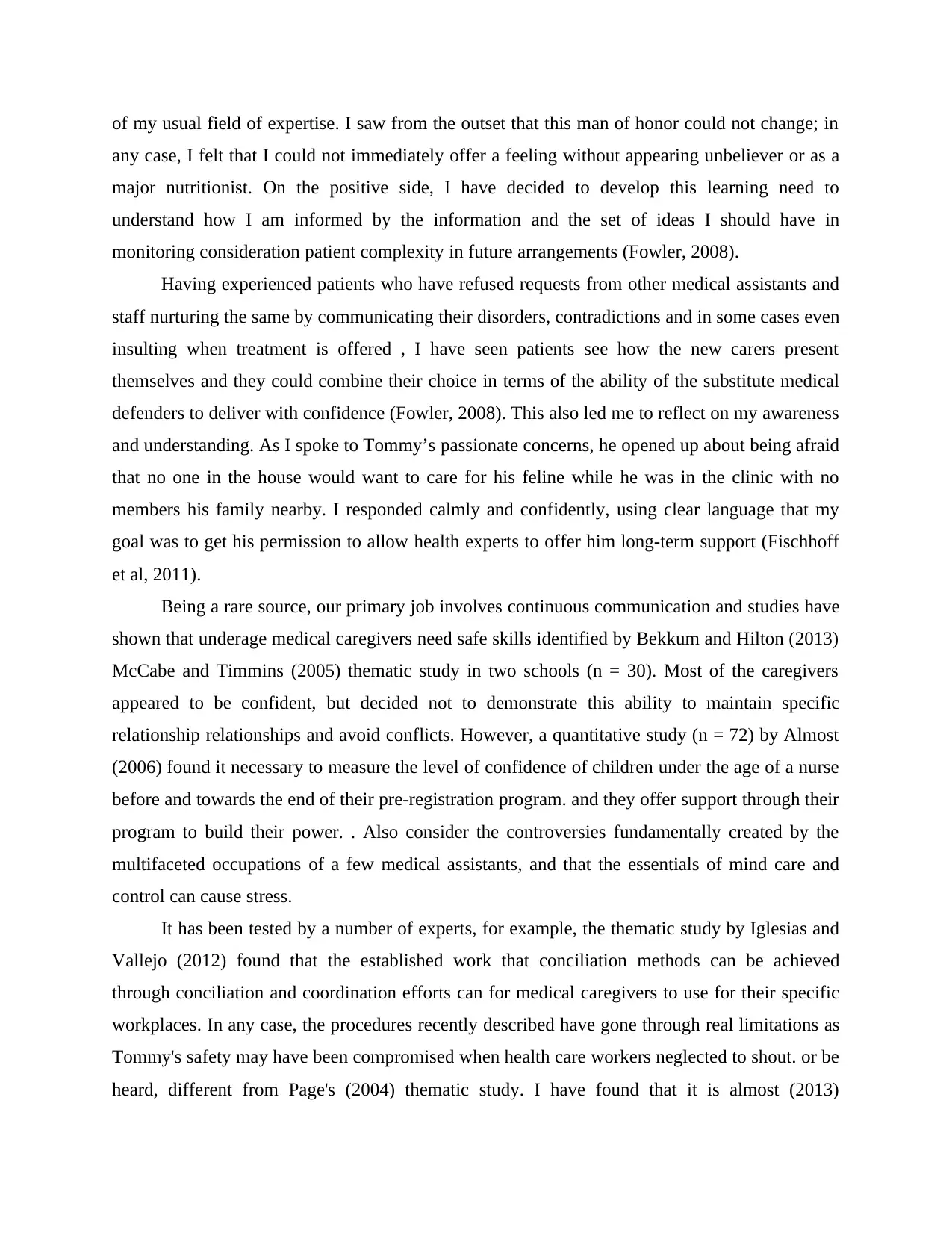
of my usual field of expertise. I saw from the outset that this man of honor could not change; in
any case, I felt that I could not immediately offer a feeling without appearing unbeliever or as a
major nutritionist. On the positive side, I have decided to develop this learning need to
understand how I am informed by the information and the set of ideas I should have in
monitoring consideration patient complexity in future arrangements (Fowler, 2008).
Having experienced patients who have refused requests from other medical assistants and
staff nurturing the same by communicating their disorders, contradictions and in some cases even
insulting when treatment is offered , I have seen patients see how the new carers present
themselves and they could combine their choice in terms of the ability of the substitute medical
defenders to deliver with confidence (Fowler, 2008). This also led me to reflect on my awareness
and understanding. As I spoke to Tommy’s passionate concerns, he opened up about being afraid
that no one in the house would want to care for his feline while he was in the clinic with no
members his family nearby. I responded calmly and confidently, using clear language that my
goal was to get his permission to allow health experts to offer him long-term support (Fischhoff
et al, 2011).
Being a rare source, our primary job involves continuous communication and studies have
shown that underage medical caregivers need safe skills identified by Bekkum and Hilton (2013)
McCabe and Timmins (2005) thematic study in two schools (n = 30). Most of the caregivers
appeared to be confident, but decided not to demonstrate this ability to maintain specific
relationship relationships and avoid conflicts. However, a quantitative study (n = 72) by Almost
(2006) found it necessary to measure the level of confidence of children under the age of a nurse
before and towards the end of their pre-registration program. and they offer support through their
program to build their power. . Also consider the controversies fundamentally created by the
multifaceted occupations of a few medical assistants, and that the essentials of mind care and
control can cause stress.
It has been tested by a number of experts, for example, the thematic study by Iglesias and
Vallejo (2012) found that the established work that conciliation methods can be achieved
through conciliation and coordination efforts can for medical caregivers to use for their specific
workplaces. In any case, the procedures recently described have gone through real limitations as
Tommy's safety may have been compromised when health care workers neglected to shout. or be
heard, different from Page's (2004) thematic study. I have found that it is almost (2013)
any case, I felt that I could not immediately offer a feeling without appearing unbeliever or as a
major nutritionist. On the positive side, I have decided to develop this learning need to
understand how I am informed by the information and the set of ideas I should have in
monitoring consideration patient complexity in future arrangements (Fowler, 2008).
Having experienced patients who have refused requests from other medical assistants and
staff nurturing the same by communicating their disorders, contradictions and in some cases even
insulting when treatment is offered , I have seen patients see how the new carers present
themselves and they could combine their choice in terms of the ability of the substitute medical
defenders to deliver with confidence (Fowler, 2008). This also led me to reflect on my awareness
and understanding. As I spoke to Tommy’s passionate concerns, he opened up about being afraid
that no one in the house would want to care for his feline while he was in the clinic with no
members his family nearby. I responded calmly and confidently, using clear language that my
goal was to get his permission to allow health experts to offer him long-term support (Fischhoff
et al, 2011).
Being a rare source, our primary job involves continuous communication and studies have
shown that underage medical caregivers need safe skills identified by Bekkum and Hilton (2013)
McCabe and Timmins (2005) thematic study in two schools (n = 30). Most of the caregivers
appeared to be confident, but decided not to demonstrate this ability to maintain specific
relationship relationships and avoid conflicts. However, a quantitative study (n = 72) by Almost
(2006) found it necessary to measure the level of confidence of children under the age of a nurse
before and towards the end of their pre-registration program. and they offer support through their
program to build their power. . Also consider the controversies fundamentally created by the
multifaceted occupations of a few medical assistants, and that the essentials of mind care and
control can cause stress.
It has been tested by a number of experts, for example, the thematic study by Iglesias and
Vallejo (2012) found that the established work that conciliation methods can be achieved
through conciliation and coordination efforts can for medical caregivers to use for their specific
workplaces. In any case, the procedures recently described have gone through real limitations as
Tommy's safety may have been compromised when health care workers neglected to shout. or be
heard, different from Page's (2004) thematic study. I have found that it is almost (2013)
⊘ This is a preview!⊘
Do you want full access?
Subscribe today to unlock all pages.

Trusted by 1+ million students worldwide
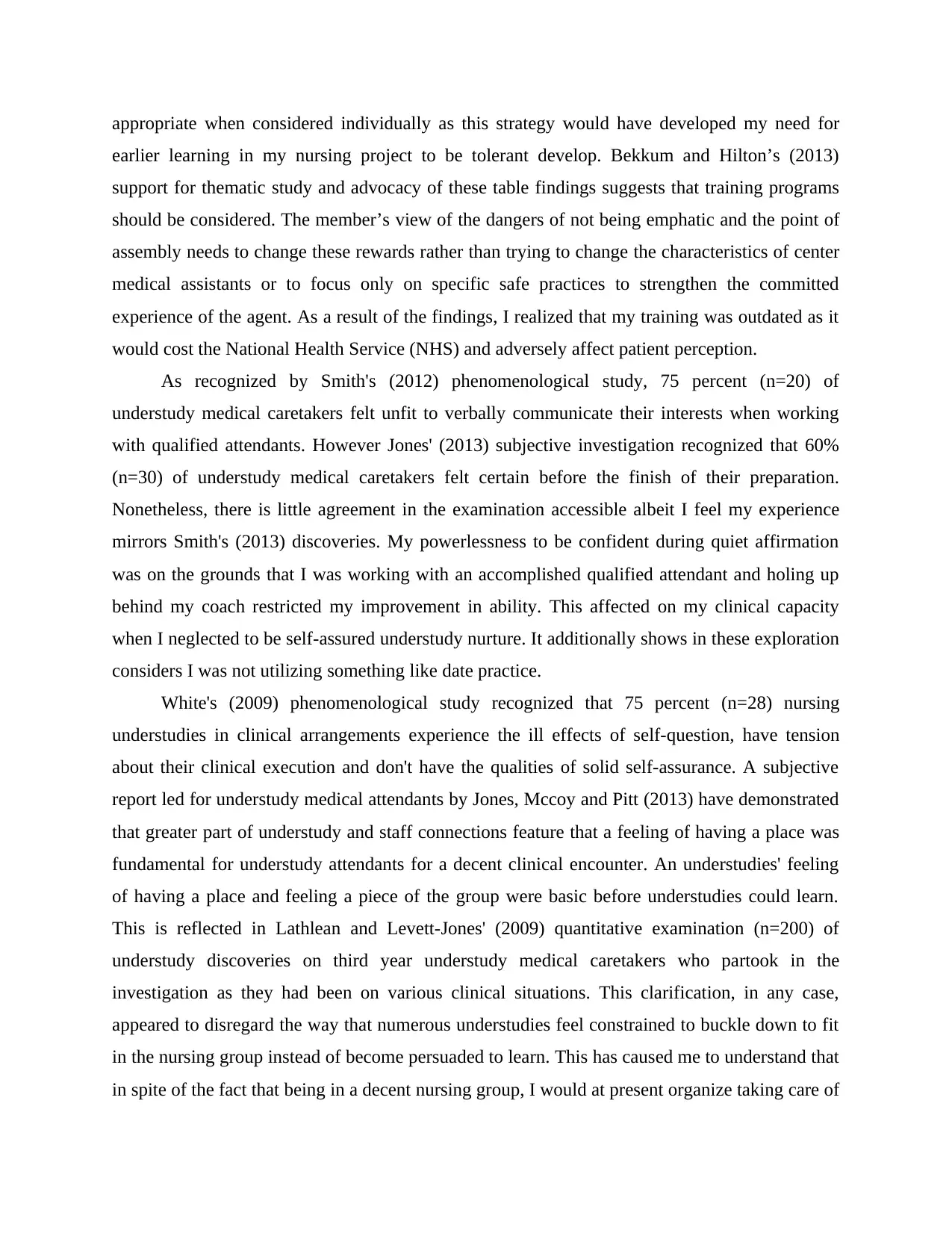
appropriate when considered individually as this strategy would have developed my need for
earlier learning in my nursing project to be tolerant develop. Bekkum and Hilton’s (2013)
support for thematic study and advocacy of these table findings suggests that training programs
should be considered. The member’s view of the dangers of not being emphatic and the point of
assembly needs to change these rewards rather than trying to change the characteristics of center
medical assistants or to focus only on specific safe practices to strengthen the committed
experience of the agent. As a result of the findings, I realized that my training was outdated as it
would cost the National Health Service (NHS) and adversely affect patient perception.
As recognized by Smith's (2012) phenomenological study, 75 percent (n=20) of
understudy medical caretakers felt unfit to verbally communicate their interests when working
with qualified attendants. However Jones' (2013) subjective investigation recognized that 60%
(n=30) of understudy medical caretakers felt certain before the finish of their preparation.
Nonetheless, there is little agreement in the examination accessible albeit I feel my experience
mirrors Smith's (2013) discoveries. My powerlessness to be confident during quiet affirmation
was on the grounds that I was working with an accomplished qualified attendant and holing up
behind my coach restricted my improvement in ability. This affected on my clinical capacity
when I neglected to be self-assured understudy nurture. It additionally shows in these exploration
considers I was not utilizing something like date practice.
White's (2009) phenomenological study recognized that 75 percent (n=28) nursing
understudies in clinical arrangements experience the ill effects of self-question, have tension
about their clinical execution and don't have the qualities of solid self-assurance. A subjective
report led for understudy medical attendants by Jones, Mccoy and Pitt (2013) have demonstrated
that greater part of understudy and staff connections feature that a feeling of having a place was
fundamental for understudy attendants for a decent clinical encounter. An understudies' feeling
of having a place and feeling a piece of the group were basic before understudies could learn.
This is reflected in Lathlean and Levett-Jones' (2009) quantitative examination (n=200) of
understudy discoveries on third year understudy medical caretakers who partook in the
investigation as they had been on various clinical situations. This clarification, in any case,
appeared to disregard the way that numerous understudies feel constrained to buckle down to fit
in the nursing group instead of become persuaded to learn. This has caused me to understand that
in spite of the fact that being in a decent nursing group, I would at present organize taking care of
earlier learning in my nursing project to be tolerant develop. Bekkum and Hilton’s (2013)
support for thematic study and advocacy of these table findings suggests that training programs
should be considered. The member’s view of the dangers of not being emphatic and the point of
assembly needs to change these rewards rather than trying to change the characteristics of center
medical assistants or to focus only on specific safe practices to strengthen the committed
experience of the agent. As a result of the findings, I realized that my training was outdated as it
would cost the National Health Service (NHS) and adversely affect patient perception.
As recognized by Smith's (2012) phenomenological study, 75 percent (n=20) of
understudy medical caretakers felt unfit to verbally communicate their interests when working
with qualified attendants. However Jones' (2013) subjective investigation recognized that 60%
(n=30) of understudy medical caretakers felt certain before the finish of their preparation.
Nonetheless, there is little agreement in the examination accessible albeit I feel my experience
mirrors Smith's (2013) discoveries. My powerlessness to be confident during quiet affirmation
was on the grounds that I was working with an accomplished qualified attendant and holing up
behind my coach restricted my improvement in ability. This affected on my clinical capacity
when I neglected to be self-assured understudy nurture. It additionally shows in these exploration
considers I was not utilizing something like date practice.
White's (2009) phenomenological study recognized that 75 percent (n=28) nursing
understudies in clinical arrangements experience the ill effects of self-question, have tension
about their clinical execution and don't have the qualities of solid self-assurance. A subjective
report led for understudy medical attendants by Jones, Mccoy and Pitt (2013) have demonstrated
that greater part of understudy and staff connections feature that a feeling of having a place was
fundamental for understudy attendants for a decent clinical encounter. An understudies' feeling
of having a place and feeling a piece of the group were basic before understudies could learn.
This is reflected in Lathlean and Levett-Jones' (2009) quantitative examination (n=200) of
understudy discoveries on third year understudy medical caretakers who partook in the
investigation as they had been on various clinical situations. This clarification, in any case,
appeared to disregard the way that numerous understudies feel constrained to buckle down to fit
in the nursing group instead of become persuaded to learn. This has caused me to understand that
in spite of the fact that being in a decent nursing group, I would at present organize taking care of
Paraphrase This Document
Need a fresh take? Get an instant paraphrase of this document with our AI Paraphraser
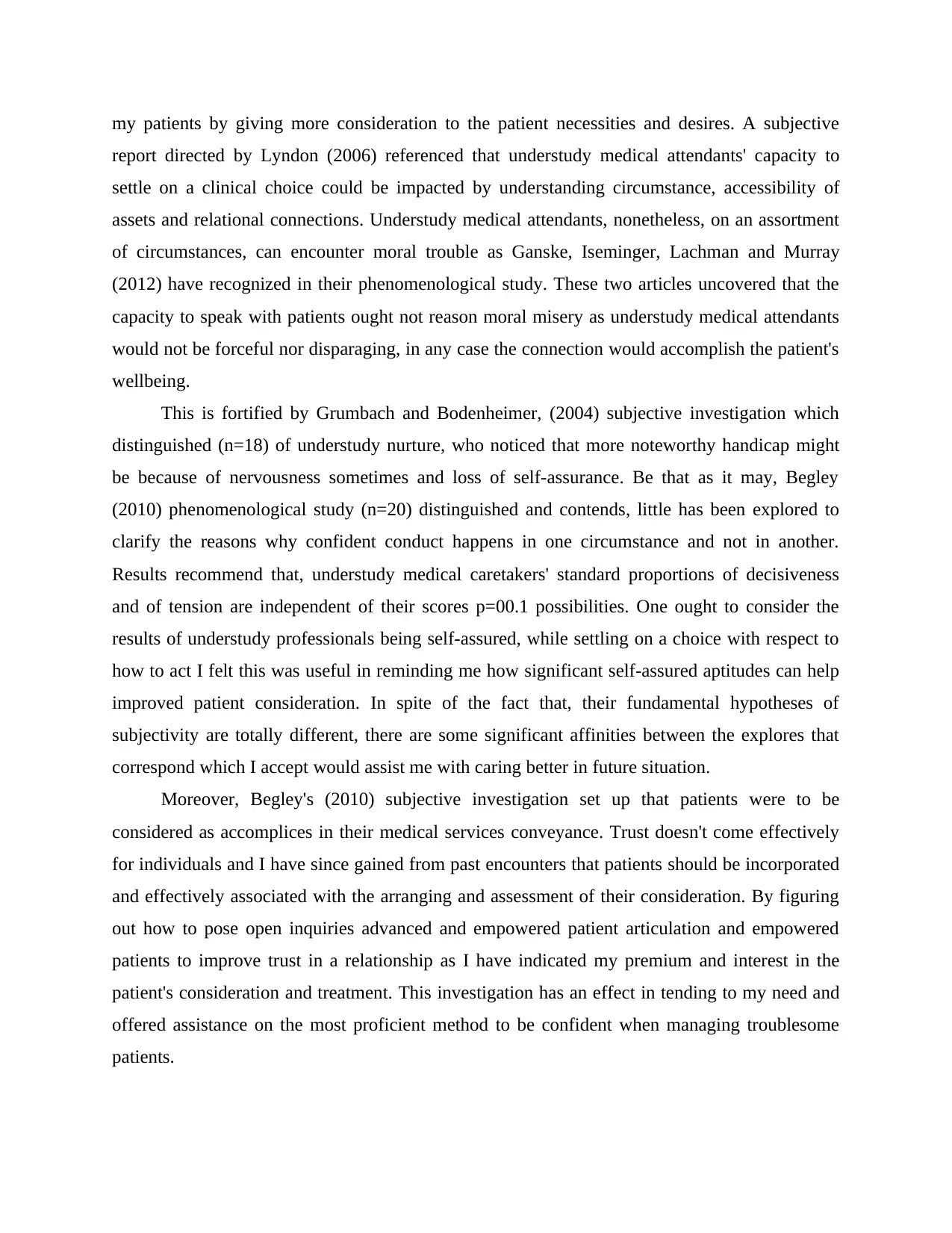
my patients by giving more consideration to the patient necessities and desires. A subjective
report directed by Lyndon (2006) referenced that understudy medical attendants' capacity to
settle on a clinical choice could be impacted by understanding circumstance, accessibility of
assets and relational connections. Understudy medical attendants, nonetheless, on an assortment
of circumstances, can encounter moral trouble as Ganske, Iseminger, Lachman and Murray
(2012) have recognized in their phenomenological study. These two articles uncovered that the
capacity to speak with patients ought not reason moral misery as understudy medical attendants
would not be forceful nor disparaging, in any case the connection would accomplish the patient's
wellbeing.
This is fortified by Grumbach and Bodenheimer, (2004) subjective investigation which
distinguished (n=18) of understudy nurture, who noticed that more noteworthy handicap might
be because of nervousness sometimes and loss of self-assurance. Be that as it may, Begley
(2010) phenomenological study (n=20) distinguished and contends, little has been explored to
clarify the reasons why confident conduct happens in one circumstance and not in another.
Results recommend that, understudy medical caretakers' standard proportions of decisiveness
and of tension are independent of their scores p=00.1 possibilities. One ought to consider the
results of understudy professionals being self-assured, while settling on a choice with respect to
how to act I felt this was useful in reminding me how significant self-assured aptitudes can help
improved patient consideration. In spite of the fact that, their fundamental hypotheses of
subjectivity are totally different, there are some significant affinities between the explores that
correspond which I accept would assist me with caring better in future situation.
Moreover, Begley's (2010) subjective investigation set up that patients were to be
considered as accomplices in their medical services conveyance. Trust doesn't come effectively
for individuals and I have since gained from past encounters that patients should be incorporated
and effectively associated with the arranging and assessment of their consideration. By figuring
out how to pose open inquiries advanced and empowered patient articulation and empowered
patients to improve trust in a relationship as I have indicated my premium and interest in the
patient's consideration and treatment. This investigation has an effect in tending to my need and
offered assistance on the most proficient method to be confident when managing troublesome
patients.
report directed by Lyndon (2006) referenced that understudy medical attendants' capacity to
settle on a clinical choice could be impacted by understanding circumstance, accessibility of
assets and relational connections. Understudy medical attendants, nonetheless, on an assortment
of circumstances, can encounter moral trouble as Ganske, Iseminger, Lachman and Murray
(2012) have recognized in their phenomenological study. These two articles uncovered that the
capacity to speak with patients ought not reason moral misery as understudy medical attendants
would not be forceful nor disparaging, in any case the connection would accomplish the patient's
wellbeing.
This is fortified by Grumbach and Bodenheimer, (2004) subjective investigation which
distinguished (n=18) of understudy nurture, who noticed that more noteworthy handicap might
be because of nervousness sometimes and loss of self-assurance. Be that as it may, Begley
(2010) phenomenological study (n=20) distinguished and contends, little has been explored to
clarify the reasons why confident conduct happens in one circumstance and not in another.
Results recommend that, understudy medical caretakers' standard proportions of decisiveness
and of tension are independent of their scores p=00.1 possibilities. One ought to consider the
results of understudy professionals being self-assured, while settling on a choice with respect to
how to act I felt this was useful in reminding me how significant self-assured aptitudes can help
improved patient consideration. In spite of the fact that, their fundamental hypotheses of
subjectivity are totally different, there are some significant affinities between the explores that
correspond which I accept would assist me with caring better in future situation.
Moreover, Begley's (2010) subjective investigation set up that patients were to be
considered as accomplices in their medical services conveyance. Trust doesn't come effectively
for individuals and I have since gained from past encounters that patients should be incorporated
and effectively associated with the arranging and assessment of their consideration. By figuring
out how to pose open inquiries advanced and empowered patient articulation and empowered
patients to improve trust in a relationship as I have indicated my premium and interest in the
patient's consideration and treatment. This investigation has an effect in tending to my need and
offered assistance on the most proficient method to be confident when managing troublesome
patients.
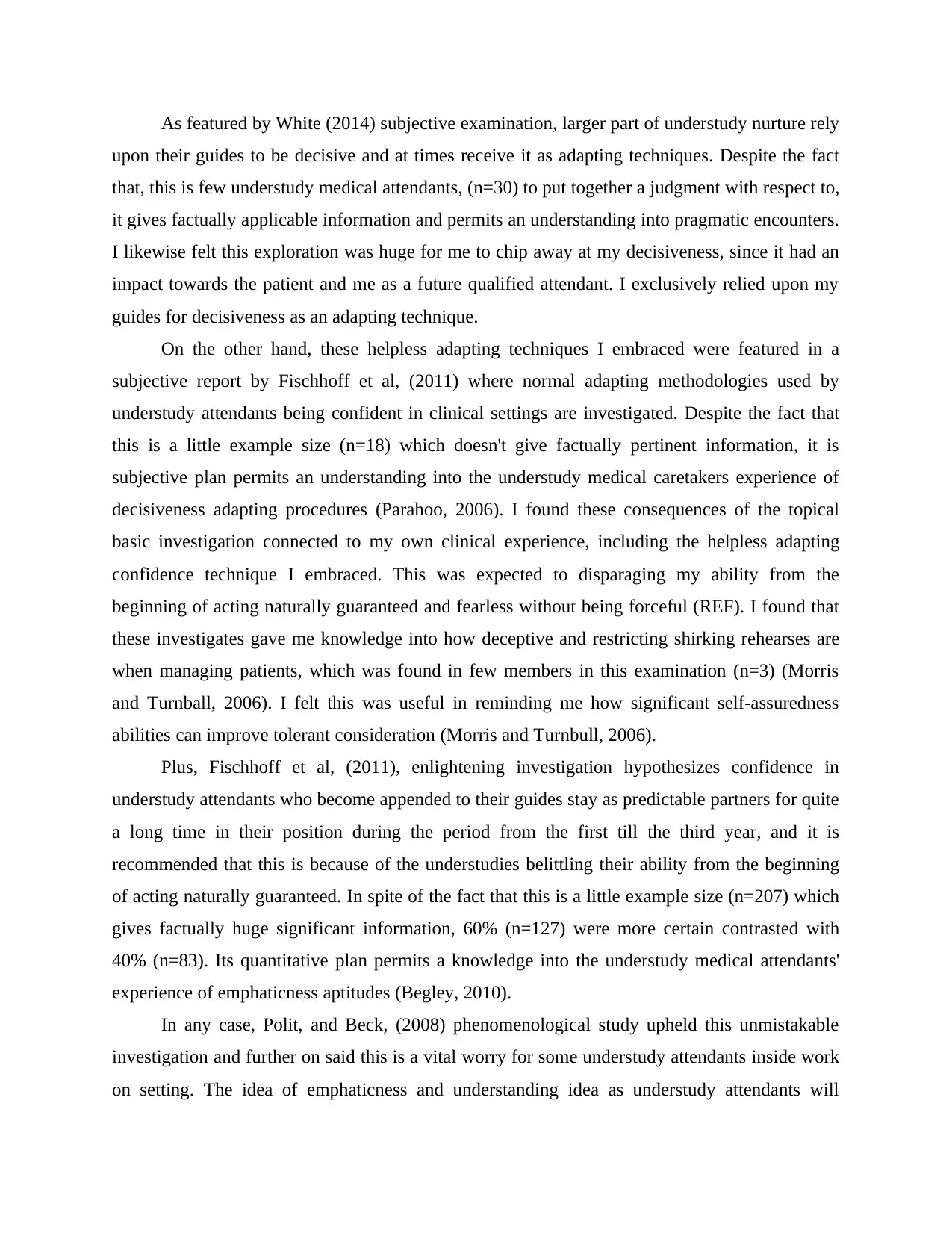
As featured by White (2014) subjective examination, larger part of understudy nurture rely
upon their guides to be decisive and at times receive it as adapting techniques. Despite the fact
that, this is few understudy medical attendants, (n=30) to put together a judgment with respect to,
it gives factually applicable information and permits an understanding into pragmatic encounters.
I likewise felt this exploration was huge for me to chip away at my decisiveness, since it had an
impact towards the patient and me as a future qualified attendant. I exclusively relied upon my
guides for decisiveness as an adapting technique.
On the other hand, these helpless adapting techniques I embraced were featured in a
subjective report by Fischhoff et al, (2011) where normal adapting methodologies used by
understudy attendants being confident in clinical settings are investigated. Despite the fact that
this is a little example size (n=18) which doesn't give factually pertinent information, it is
subjective plan permits an understanding into the understudy medical caretakers experience of
decisiveness adapting procedures (Parahoo, 2006). I found these consequences of the topical
basic investigation connected to my own clinical experience, including the helpless adapting
confidence technique I embraced. This was expected to disparaging my ability from the
beginning of acting naturally guaranteed and fearless without being forceful (REF). I found that
these investigates gave me knowledge into how deceptive and restricting shirking rehearses are
when managing patients, which was found in few members in this examination (n=3) (Morris
and Turnball, 2006). I felt this was useful in reminding me how significant self-assuredness
abilities can improve tolerant consideration (Morris and Turnbull, 2006).
Plus, Fischhoff et al, (2011), enlightening investigation hypothesizes confidence in
understudy attendants who become appended to their guides stay as predictable partners for quite
a long time in their position during the period from the first till the third year, and it is
recommended that this is because of the understudies belittling their ability from the beginning
of acting naturally guaranteed. In spite of the fact that this is a little example size (n=207) which
gives factually huge significant information, 60% (n=127) were more certain contrasted with
40% (n=83). Its quantitative plan permits a knowledge into the understudy medical attendants'
experience of emphaticness aptitudes (Begley, 2010).
In any case, Polit, and Beck, (2008) phenomenological study upheld this unmistakable
investigation and further on said this is a vital worry for some understudy attendants inside work
on setting. The idea of emphaticness and understanding idea as understudy attendants will
upon their guides to be decisive and at times receive it as adapting techniques. Despite the fact
that, this is few understudy medical attendants, (n=30) to put together a judgment with respect to,
it gives factually applicable information and permits an understanding into pragmatic encounters.
I likewise felt this exploration was huge for me to chip away at my decisiveness, since it had an
impact towards the patient and me as a future qualified attendant. I exclusively relied upon my
guides for decisiveness as an adapting technique.
On the other hand, these helpless adapting techniques I embraced were featured in a
subjective report by Fischhoff et al, (2011) where normal adapting methodologies used by
understudy attendants being confident in clinical settings are investigated. Despite the fact that
this is a little example size (n=18) which doesn't give factually pertinent information, it is
subjective plan permits an understanding into the understudy medical caretakers experience of
decisiveness adapting procedures (Parahoo, 2006). I found these consequences of the topical
basic investigation connected to my own clinical experience, including the helpless adapting
confidence technique I embraced. This was expected to disparaging my ability from the
beginning of acting naturally guaranteed and fearless without being forceful (REF). I found that
these investigates gave me knowledge into how deceptive and restricting shirking rehearses are
when managing patients, which was found in few members in this examination (n=3) (Morris
and Turnball, 2006). I felt this was useful in reminding me how significant self-assuredness
abilities can improve tolerant consideration (Morris and Turnbull, 2006).
Plus, Fischhoff et al, (2011), enlightening investigation hypothesizes confidence in
understudy attendants who become appended to their guides stay as predictable partners for quite
a long time in their position during the period from the first till the third year, and it is
recommended that this is because of the understudies belittling their ability from the beginning
of acting naturally guaranteed. In spite of the fact that this is a little example size (n=207) which
gives factually huge significant information, 60% (n=127) were more certain contrasted with
40% (n=83). Its quantitative plan permits a knowledge into the understudy medical attendants'
experience of emphaticness aptitudes (Begley, 2010).
In any case, Polit, and Beck, (2008) phenomenological study upheld this unmistakable
investigation and further on said this is a vital worry for some understudy attendants inside work
on setting. The idea of emphaticness and understanding idea as understudy attendants will
⊘ This is a preview!⊘
Do you want full access?
Subscribe today to unlock all pages.

Trusted by 1+ million students worldwide
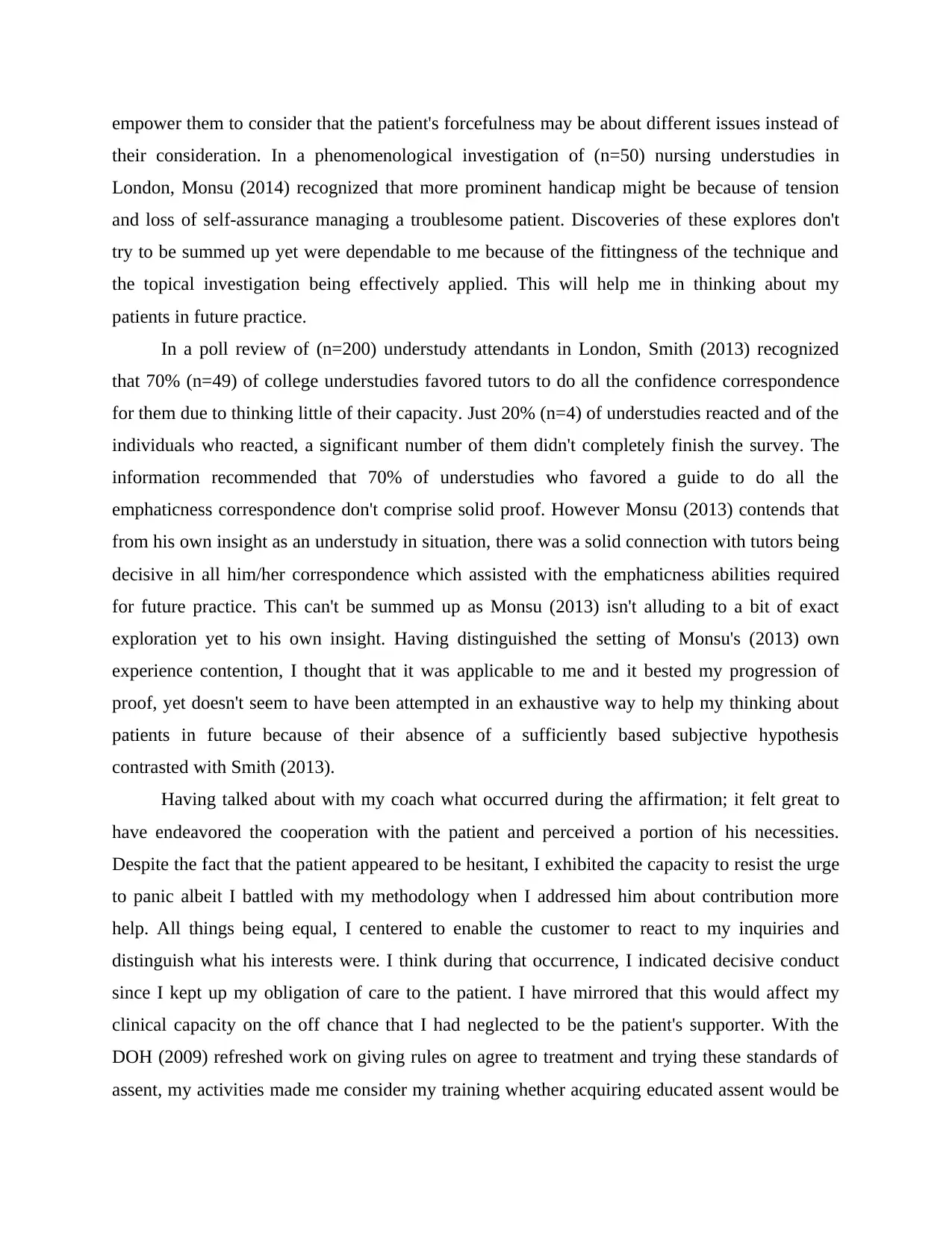
empower them to consider that the patient's forcefulness may be about different issues instead of
their consideration. In a phenomenological investigation of (n=50) nursing understudies in
London, Monsu (2014) recognized that more prominent handicap might be because of tension
and loss of self-assurance managing a troublesome patient. Discoveries of these explores don't
try to be summed up yet were dependable to me because of the fittingness of the technique and
the topical investigation being effectively applied. This will help me in thinking about my
patients in future practice.
In a poll review of (n=200) understudy attendants in London, Smith (2013) recognized
that 70% (n=49) of college understudies favored tutors to do all the confidence correspondence
for them due to thinking little of their capacity. Just 20% (n=4) of understudies reacted and of the
individuals who reacted, a significant number of them didn't completely finish the survey. The
information recommended that 70% of understudies who favored a guide to do all the
emphaticness correspondence don't comprise solid proof. However Monsu (2013) contends that
from his own insight as an understudy in situation, there was a solid connection with tutors being
decisive in all him/her correspondence which assisted with the emphaticness abilities required
for future practice. This can't be summed up as Monsu (2013) isn't alluding to a bit of exact
exploration yet to his own insight. Having distinguished the setting of Monsu's (2013) own
experience contention, I thought that it was applicable to me and it bested my progression of
proof, yet doesn't seem to have been attempted in an exhaustive way to help my thinking about
patients in future because of their absence of a sufficiently based subjective hypothesis
contrasted with Smith (2013).
Having talked about with my coach what occurred during the affirmation; it felt great to
have endeavored the cooperation with the patient and perceived a portion of his necessities.
Despite the fact that the patient appeared to be hesitant, I exhibited the capacity to resist the urge
to panic albeit I battled with my methodology when I addressed him about contribution more
help. All things being equal, I centered to enable the customer to react to my inquiries and
distinguish what his interests were. I think during that occurrence, I indicated decisive conduct
since I kept up my obligation of care to the patient. I have mirrored that this would affect my
clinical capacity on the off chance that I had neglected to be the patient's supporter. With the
DOH (2009) refreshed work on giving rules on agree to treatment and trying these standards of
assent, my activities made me consider my training whether acquiring educated assent would be
their consideration. In a phenomenological investigation of (n=50) nursing understudies in
London, Monsu (2014) recognized that more prominent handicap might be because of tension
and loss of self-assurance managing a troublesome patient. Discoveries of these explores don't
try to be summed up yet were dependable to me because of the fittingness of the technique and
the topical investigation being effectively applied. This will help me in thinking about my
patients in future practice.
In a poll review of (n=200) understudy attendants in London, Smith (2013) recognized
that 70% (n=49) of college understudies favored tutors to do all the confidence correspondence
for them due to thinking little of their capacity. Just 20% (n=4) of understudies reacted and of the
individuals who reacted, a significant number of them didn't completely finish the survey. The
information recommended that 70% of understudies who favored a guide to do all the
emphaticness correspondence don't comprise solid proof. However Monsu (2013) contends that
from his own insight as an understudy in situation, there was a solid connection with tutors being
decisive in all him/her correspondence which assisted with the emphaticness abilities required
for future practice. This can't be summed up as Monsu (2013) isn't alluding to a bit of exact
exploration yet to his own insight. Having distinguished the setting of Monsu's (2013) own
experience contention, I thought that it was applicable to me and it bested my progression of
proof, yet doesn't seem to have been attempted in an exhaustive way to help my thinking about
patients in future because of their absence of a sufficiently based subjective hypothesis
contrasted with Smith (2013).
Having talked about with my coach what occurred during the affirmation; it felt great to
have endeavored the cooperation with the patient and perceived a portion of his necessities.
Despite the fact that the patient appeared to be hesitant, I exhibited the capacity to resist the urge
to panic albeit I battled with my methodology when I addressed him about contribution more
help. All things being equal, I centered to enable the customer to react to my inquiries and
distinguish what his interests were. I think during that occurrence, I indicated decisive conduct
since I kept up my obligation of care to the patient. I have mirrored that this would affect my
clinical capacity on the off chance that I had neglected to be the patient's supporter. With the
DOH (2009) refreshed work on giving rules on agree to treatment and trying these standards of
assent, my activities made me consider my training whether acquiring educated assent would be
Paraphrase This Document
Need a fresh take? Get an instant paraphrase of this document with our AI Paraphraser
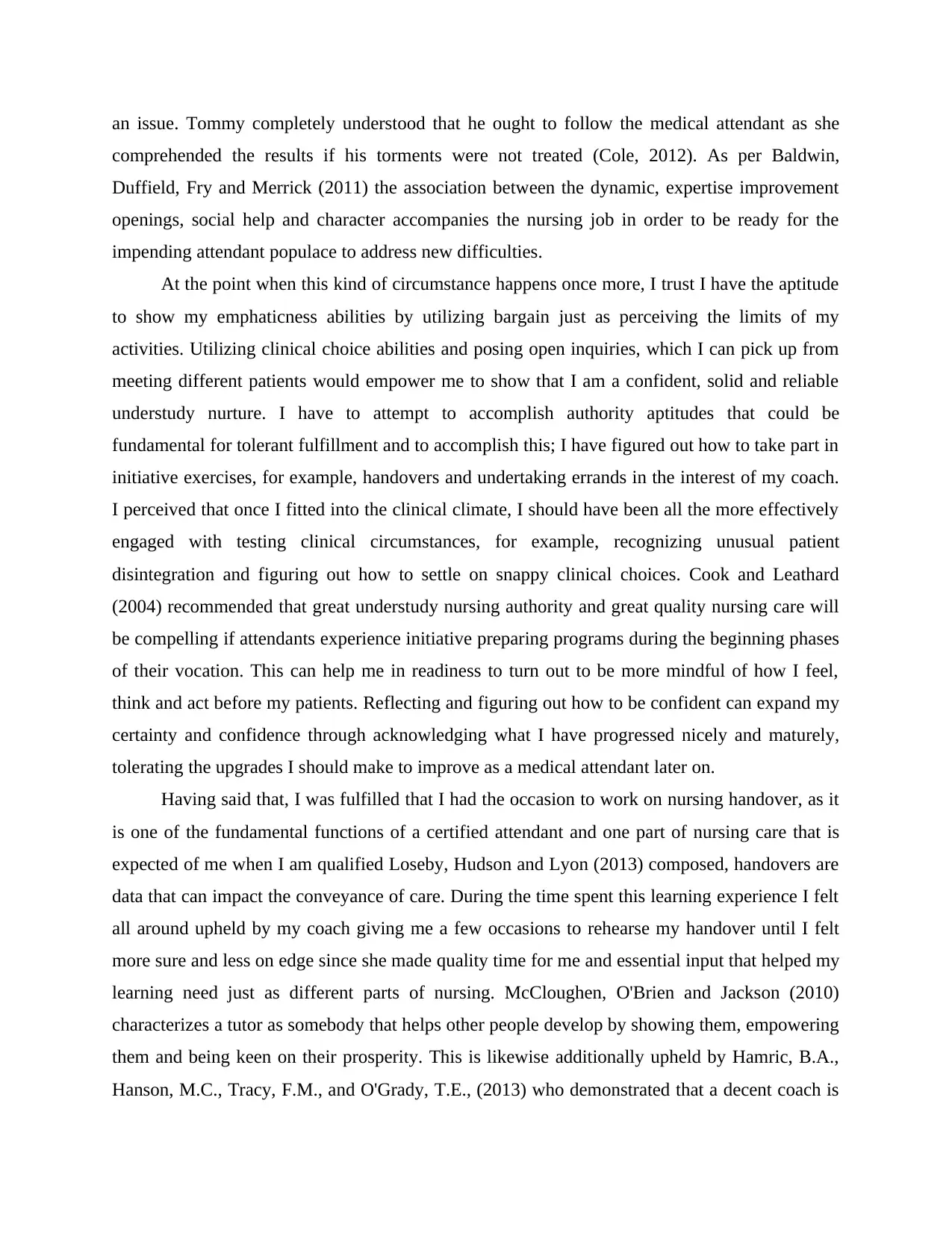
an issue. Tommy completely understood that he ought to follow the medical attendant as she
comprehended the results if his torments were not treated (Cole, 2012). As per Baldwin,
Duffield, Fry and Merrick (2011) the association between the dynamic, expertise improvement
openings, social help and character accompanies the nursing job in order to be ready for the
impending attendant populace to address new difficulties.
At the point when this kind of circumstance happens once more, I trust I have the aptitude
to show my emphaticness abilities by utilizing bargain just as perceiving the limits of my
activities. Utilizing clinical choice abilities and posing open inquiries, which I can pick up from
meeting different patients would empower me to show that I am a confident, solid and reliable
understudy nurture. I have to attempt to accomplish authority aptitudes that could be
fundamental for tolerant fulfillment and to accomplish this; I have figured out how to take part in
initiative exercises, for example, handovers and undertaking errands in the interest of my coach.
I perceived that once I fitted into the clinical climate, I should have been all the more effectively
engaged with testing clinical circumstances, for example, recognizing unusual patient
disintegration and figuring out how to settle on snappy clinical choices. Cook and Leathard
(2004) recommended that great understudy nursing authority and great quality nursing care will
be compelling if attendants experience initiative preparing programs during the beginning phases
of their vocation. This can help me in readiness to turn out to be more mindful of how I feel,
think and act before my patients. Reflecting and figuring out how to be confident can expand my
certainty and confidence through acknowledging what I have progressed nicely and maturely,
tolerating the upgrades I should make to improve as a medical attendant later on.
Having said that, I was fulfilled that I had the occasion to work on nursing handover, as it
is one of the fundamental functions of a certified attendant and one part of nursing care that is
expected of me when I am qualified Loseby, Hudson and Lyon (2013) composed, handovers are
data that can impact the conveyance of care. During the time spent this learning experience I felt
all around upheld by my coach giving me a few occasions to rehearse my handover until I felt
more sure and less on edge since she made quality time for me and essential input that helped my
learning need just as different parts of nursing. McCloughen, O'Brien and Jackson (2010)
characterizes a tutor as somebody that helps other people develop by showing them, empowering
them and being keen on their prosperity. This is likewise additionally upheld by Hamric, B.A.,
Hanson, M.C., Tracy, F.M., and O'Grady, T.E., (2013) who demonstrated that a decent coach is
comprehended the results if his torments were not treated (Cole, 2012). As per Baldwin,
Duffield, Fry and Merrick (2011) the association between the dynamic, expertise improvement
openings, social help and character accompanies the nursing job in order to be ready for the
impending attendant populace to address new difficulties.
At the point when this kind of circumstance happens once more, I trust I have the aptitude
to show my emphaticness abilities by utilizing bargain just as perceiving the limits of my
activities. Utilizing clinical choice abilities and posing open inquiries, which I can pick up from
meeting different patients would empower me to show that I am a confident, solid and reliable
understudy nurture. I have to attempt to accomplish authority aptitudes that could be
fundamental for tolerant fulfillment and to accomplish this; I have figured out how to take part in
initiative exercises, for example, handovers and undertaking errands in the interest of my coach.
I perceived that once I fitted into the clinical climate, I should have been all the more effectively
engaged with testing clinical circumstances, for example, recognizing unusual patient
disintegration and figuring out how to settle on snappy clinical choices. Cook and Leathard
(2004) recommended that great understudy nursing authority and great quality nursing care will
be compelling if attendants experience initiative preparing programs during the beginning phases
of their vocation. This can help me in readiness to turn out to be more mindful of how I feel,
think and act before my patients. Reflecting and figuring out how to be confident can expand my
certainty and confidence through acknowledging what I have progressed nicely and maturely,
tolerating the upgrades I should make to improve as a medical attendant later on.
Having said that, I was fulfilled that I had the occasion to work on nursing handover, as it
is one of the fundamental functions of a certified attendant and one part of nursing care that is
expected of me when I am qualified Loseby, Hudson and Lyon (2013) composed, handovers are
data that can impact the conveyance of care. During the time spent this learning experience I felt
all around upheld by my coach giving me a few occasions to rehearse my handover until I felt
more sure and less on edge since she made quality time for me and essential input that helped my
learning need just as different parts of nursing. McCloughen, O'Brien and Jackson (2010)
characterizes a tutor as somebody that helps other people develop by showing them, empowering
them and being keen on their prosperity. This is likewise additionally upheld by Hamric, B.A.,
Hanson, M.C., Tracy, F.M., and O'Grady, T.E., (2013) who demonstrated that a decent coach is
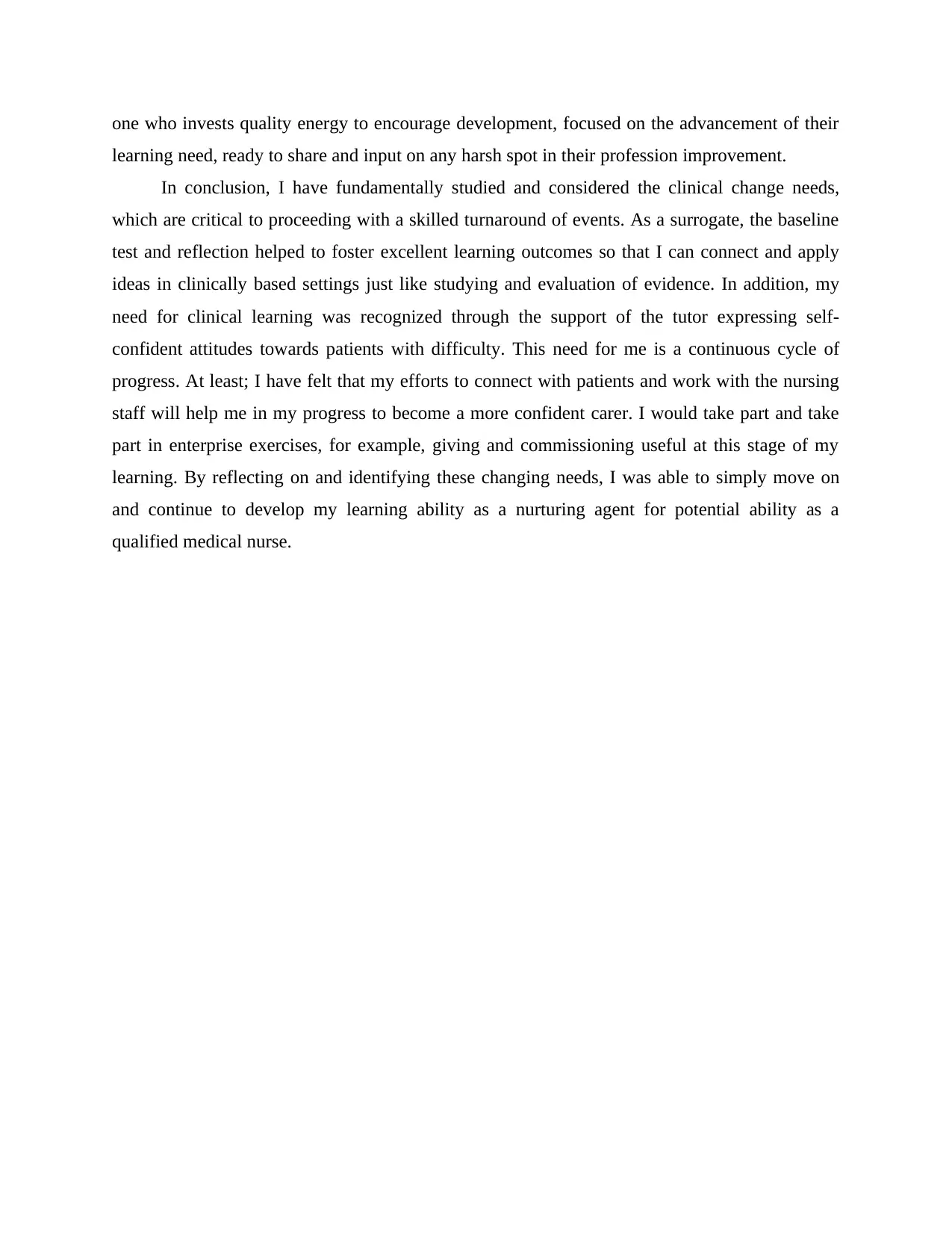
one who invests quality energy to encourage development, focused on the advancement of their
learning need, ready to share and input on any harsh spot in their profession improvement.
In conclusion, I have fundamentally studied and considered the clinical change needs,
which are critical to proceeding with a skilled turnaround of events. As a surrogate, the baseline
test and reflection helped to foster excellent learning outcomes so that I can connect and apply
ideas in clinically based settings just like studying and evaluation of evidence. In addition, my
need for clinical learning was recognized through the support of the tutor expressing self-
confident attitudes towards patients with difficulty. This need for me is a continuous cycle of
progress. At least; I have felt that my efforts to connect with patients and work with the nursing
staff will help me in my progress to become a more confident carer. I would take part and take
part in enterprise exercises, for example, giving and commissioning useful at this stage of my
learning. By reflecting on and identifying these changing needs, I was able to simply move on
and continue to develop my learning ability as a nurturing agent for potential ability as a
qualified medical nurse.
learning need, ready to share and input on any harsh spot in their profession improvement.
In conclusion, I have fundamentally studied and considered the clinical change needs,
which are critical to proceeding with a skilled turnaround of events. As a surrogate, the baseline
test and reflection helped to foster excellent learning outcomes so that I can connect and apply
ideas in clinically based settings just like studying and evaluation of evidence. In addition, my
need for clinical learning was recognized through the support of the tutor expressing self-
confident attitudes towards patients with difficulty. This need for me is a continuous cycle of
progress. At least; I have felt that my efforts to connect with patients and work with the nursing
staff will help me in my progress to become a more confident carer. I would take part and take
part in enterprise exercises, for example, giving and commissioning useful at this stage of my
learning. By reflecting on and identifying these changing needs, I was able to simply move on
and continue to develop my learning ability as a nurturing agent for potential ability as a
qualified medical nurse.
⊘ This is a preview!⊘
Do you want full access?
Subscribe today to unlock all pages.

Trusted by 1+ million students worldwide
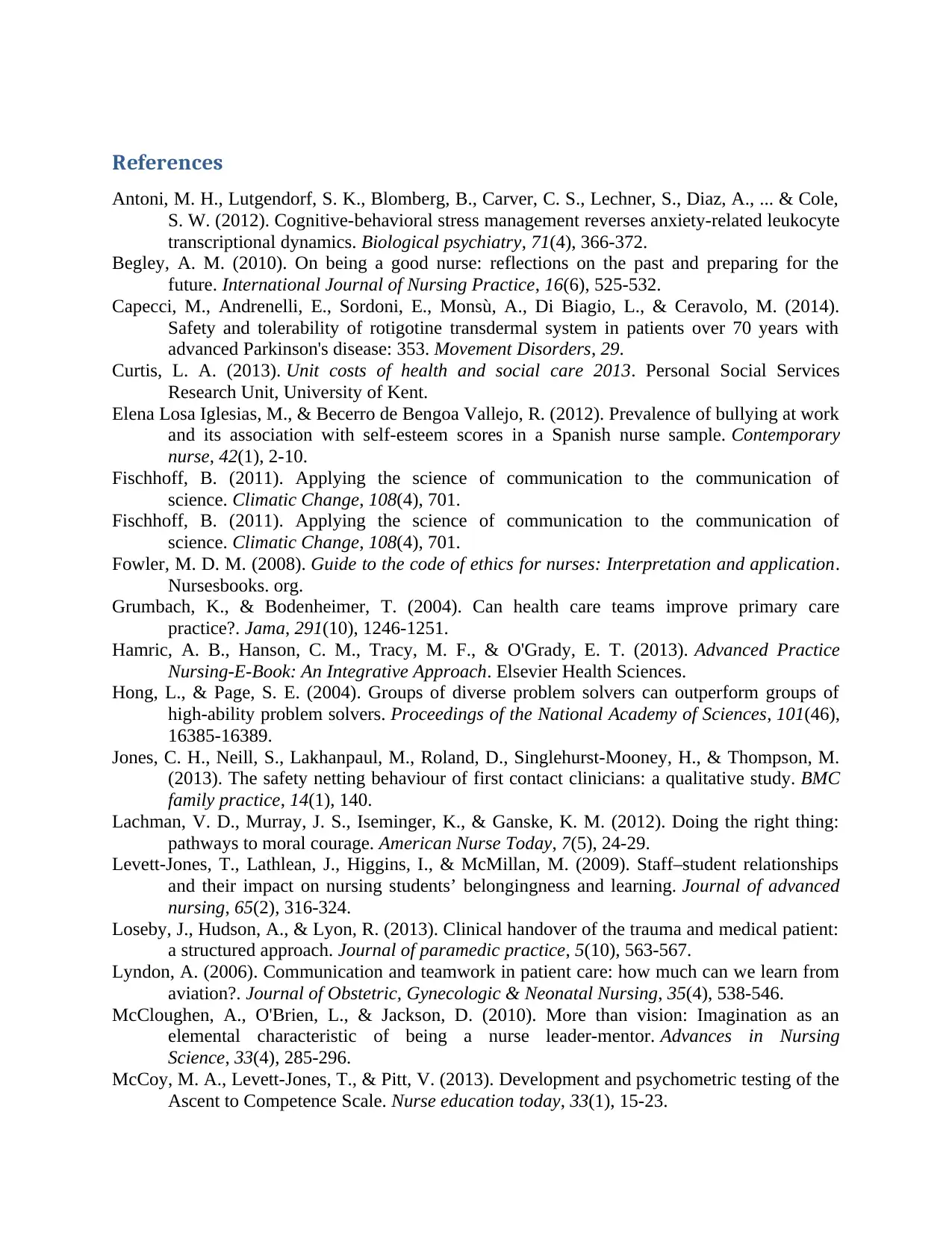
References
Antoni, M. H., Lutgendorf, S. K., Blomberg, B., Carver, C. S., Lechner, S., Diaz, A., ... & Cole,
S. W. (2012). Cognitive-behavioral stress management reverses anxiety-related leukocyte
transcriptional dynamics. Biological psychiatry, 71(4), 366-372.
Begley, A. M. (2010). On being a good nurse: reflections on the past and preparing for the
future. International Journal of Nursing Practice, 16(6), 525-532.
Capecci, M., Andrenelli, E., Sordoni, E., Monsù, A., Di Biagio, L., & Ceravolo, M. (2014).
Safety and tolerability of rotigotine transdermal system in patients over 70 years with
advanced Parkinson's disease: 353. Movement Disorders, 29.
Curtis, L. A. (2013). Unit costs of health and social care 2013. Personal Social Services
Research Unit, University of Kent.
Elena Losa Iglesias, M., & Becerro de Bengoa Vallejo, R. (2012). Prevalence of bullying at work
and its association with self-esteem scores in a Spanish nurse sample. Contemporary
nurse, 42(1), 2-10.
Fischhoff, B. (2011). Applying the science of communication to the communication of
science. Climatic Change, 108(4), 701.
Fischhoff, B. (2011). Applying the science of communication to the communication of
science. Climatic Change, 108(4), 701.
Fowler, M. D. M. (2008). Guide to the code of ethics for nurses: Interpretation and application.
Nursesbooks. org.
Grumbach, K., & Bodenheimer, T. (2004). Can health care teams improve primary care
practice?. Jama, 291(10), 1246-1251.
Hamric, A. B., Hanson, C. M., Tracy, M. F., & O'Grady, E. T. (2013). Advanced Practice
Nursing-E-Book: An Integrative Approach. Elsevier Health Sciences.
Hong, L., & Page, S. E. (2004). Groups of diverse problem solvers can outperform groups of
high-ability problem solvers. Proceedings of the National Academy of Sciences, 101(46),
16385-16389.
Jones, C. H., Neill, S., Lakhanpaul, M., Roland, D., Singlehurst-Mooney, H., & Thompson, M.
(2013). The safety netting behaviour of first contact clinicians: a qualitative study. BMC
family practice, 14(1), 140.
Lachman, V. D., Murray, J. S., Iseminger, K., & Ganske, K. M. (2012). Doing the right thing:
pathways to moral courage. American Nurse Today, 7(5), 24-29.
Levett‐Jones, T., Lathlean, J., Higgins, I., & McMillan, M. (2009). Staff–student relationships
and their impact on nursing students’ belongingness and learning. Journal of advanced
nursing, 65(2), 316-324.
Loseby, J., Hudson, A., & Lyon, R. (2013). Clinical handover of the trauma and medical patient:
a structured approach. Journal of paramedic practice, 5(10), 563-567.
Lyndon, A. (2006). Communication and teamwork in patient care: how much can we learn from
aviation?. Journal of Obstetric, Gynecologic & Neonatal Nursing, 35(4), 538-546.
McCloughen, A., O'Brien, L., & Jackson, D. (2010). More than vision: Imagination as an
elemental characteristic of being a nurse leader-mentor. Advances in Nursing
Science, 33(4), 285-296.
McCoy, M. A., Levett-Jones, T., & Pitt, V. (2013). Development and psychometric testing of the
Ascent to Competence Scale. Nurse education today, 33(1), 15-23.
Antoni, M. H., Lutgendorf, S. K., Blomberg, B., Carver, C. S., Lechner, S., Diaz, A., ... & Cole,
S. W. (2012). Cognitive-behavioral stress management reverses anxiety-related leukocyte
transcriptional dynamics. Biological psychiatry, 71(4), 366-372.
Begley, A. M. (2010). On being a good nurse: reflections on the past and preparing for the
future. International Journal of Nursing Practice, 16(6), 525-532.
Capecci, M., Andrenelli, E., Sordoni, E., Monsù, A., Di Biagio, L., & Ceravolo, M. (2014).
Safety and tolerability of rotigotine transdermal system in patients over 70 years with
advanced Parkinson's disease: 353. Movement Disorders, 29.
Curtis, L. A. (2013). Unit costs of health and social care 2013. Personal Social Services
Research Unit, University of Kent.
Elena Losa Iglesias, M., & Becerro de Bengoa Vallejo, R. (2012). Prevalence of bullying at work
and its association with self-esteem scores in a Spanish nurse sample. Contemporary
nurse, 42(1), 2-10.
Fischhoff, B. (2011). Applying the science of communication to the communication of
science. Climatic Change, 108(4), 701.
Fischhoff, B. (2011). Applying the science of communication to the communication of
science. Climatic Change, 108(4), 701.
Fowler, M. D. M. (2008). Guide to the code of ethics for nurses: Interpretation and application.
Nursesbooks. org.
Grumbach, K., & Bodenheimer, T. (2004). Can health care teams improve primary care
practice?. Jama, 291(10), 1246-1251.
Hamric, A. B., Hanson, C. M., Tracy, M. F., & O'Grady, E. T. (2013). Advanced Practice
Nursing-E-Book: An Integrative Approach. Elsevier Health Sciences.
Hong, L., & Page, S. E. (2004). Groups of diverse problem solvers can outperform groups of
high-ability problem solvers. Proceedings of the National Academy of Sciences, 101(46),
16385-16389.
Jones, C. H., Neill, S., Lakhanpaul, M., Roland, D., Singlehurst-Mooney, H., & Thompson, M.
(2013). The safety netting behaviour of first contact clinicians: a qualitative study. BMC
family practice, 14(1), 140.
Lachman, V. D., Murray, J. S., Iseminger, K., & Ganske, K. M. (2012). Doing the right thing:
pathways to moral courage. American Nurse Today, 7(5), 24-29.
Levett‐Jones, T., Lathlean, J., Higgins, I., & McMillan, M. (2009). Staff–student relationships
and their impact on nursing students’ belongingness and learning. Journal of advanced
nursing, 65(2), 316-324.
Loseby, J., Hudson, A., & Lyon, R. (2013). Clinical handover of the trauma and medical patient:
a structured approach. Journal of paramedic practice, 5(10), 563-567.
Lyndon, A. (2006). Communication and teamwork in patient care: how much can we learn from
aviation?. Journal of Obstetric, Gynecologic & Neonatal Nursing, 35(4), 538-546.
McCloughen, A., O'Brien, L., & Jackson, D. (2010). More than vision: Imagination as an
elemental characteristic of being a nurse leader-mentor. Advances in Nursing
Science, 33(4), 285-296.
McCoy, M. A., Levett-Jones, T., & Pitt, V. (2013). Development and psychometric testing of the
Ascent to Competence Scale. Nurse education today, 33(1), 15-23.
Paraphrase This Document
Need a fresh take? Get an instant paraphrase of this document with our AI Paraphraser
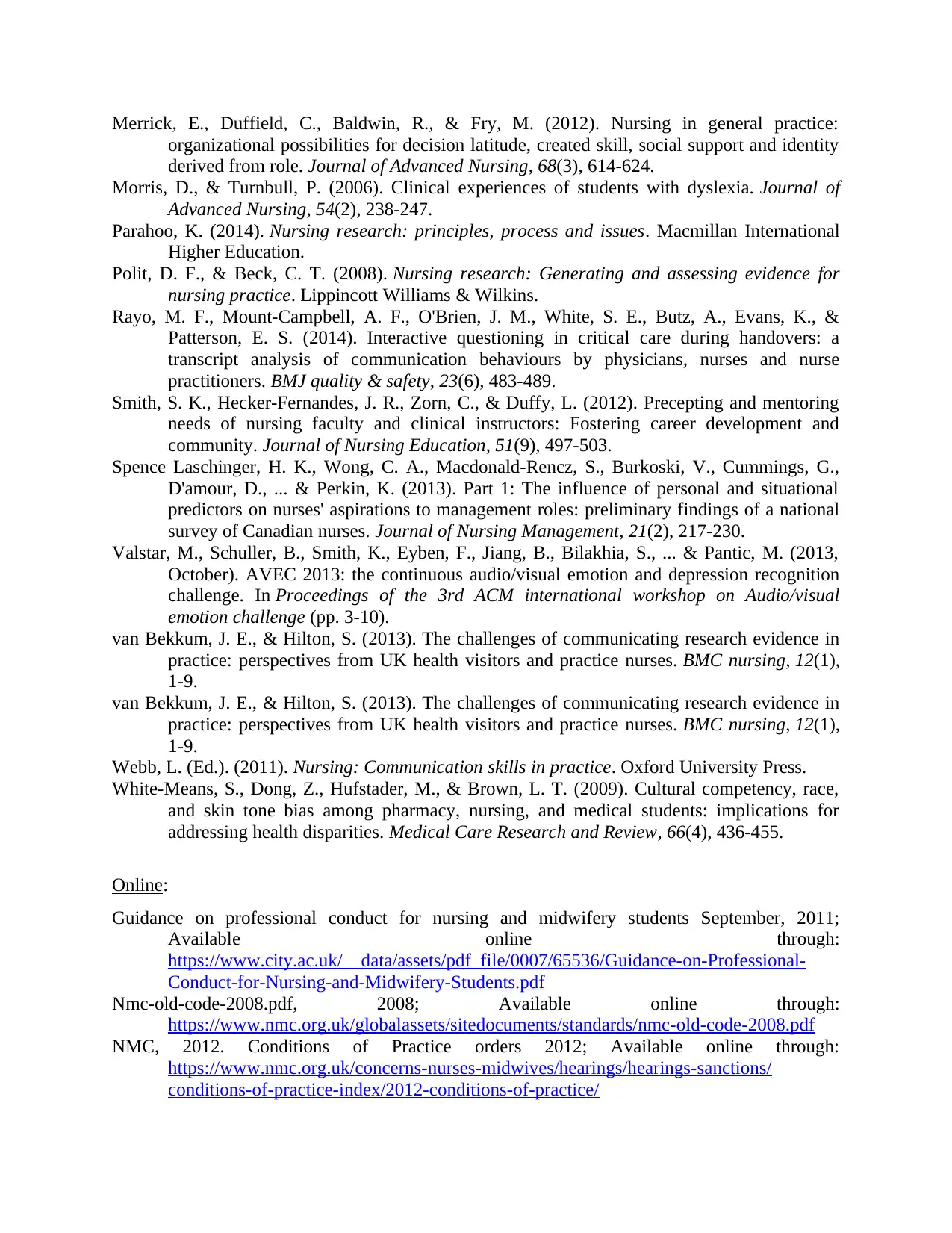
Merrick, E., Duffield, C., Baldwin, R., & Fry, M. (2012). Nursing in general practice:
organizational possibilities for decision latitude, created skill, social support and identity
derived from role. Journal of Advanced Nursing, 68(3), 614-624.
Morris, D., & Turnbull, P. (2006). Clinical experiences of students with dyslexia. Journal of
Advanced Nursing, 54(2), 238-247.
Parahoo, K. (2014). Nursing research: principles, process and issues. Macmillan International
Higher Education.
Polit, D. F., & Beck, C. T. (2008). Nursing research: Generating and assessing evidence for
nursing practice. Lippincott Williams & Wilkins.
Rayo, M. F., Mount-Campbell, A. F., O'Brien, J. M., White, S. E., Butz, A., Evans, K., &
Patterson, E. S. (2014). Interactive questioning in critical care during handovers: a
transcript analysis of communication behaviours by physicians, nurses and nurse
practitioners. BMJ quality & safety, 23(6), 483-489.
Smith, S. K., Hecker-Fernandes, J. R., Zorn, C., & Duffy, L. (2012). Precepting and mentoring
needs of nursing faculty and clinical instructors: Fostering career development and
community. Journal of Nursing Education, 51(9), 497-503.
Spence Laschinger, H. K., Wong, C. A., Macdonald‐Rencz, S., Burkoski, V., Cummings, G.,
D'amour, D., ... & Perkin, K. (2013). Part 1: The influence of personal and situational
predictors on nurses' aspirations to management roles: preliminary findings of a national
survey of Canadian nurses. Journal of Nursing Management, 21(2), 217-230.
Valstar, M., Schuller, B., Smith, K., Eyben, F., Jiang, B., Bilakhia, S., ... & Pantic, M. (2013,
October). AVEC 2013: the continuous audio/visual emotion and depression recognition
challenge. In Proceedings of the 3rd ACM international workshop on Audio/visual
emotion challenge (pp. 3-10).
van Bekkum, J. E., & Hilton, S. (2013). The challenges of communicating research evidence in
practice: perspectives from UK health visitors and practice nurses. BMC nursing, 12(1),
1-9.
van Bekkum, J. E., & Hilton, S. (2013). The challenges of communicating research evidence in
practice: perspectives from UK health visitors and practice nurses. BMC nursing, 12(1),
1-9.
Webb, L. (Ed.). (2011). Nursing: Communication skills in practice. Oxford University Press.
White-Means, S., Dong, Z., Hufstader, M., & Brown, L. T. (2009). Cultural competency, race,
and skin tone bias among pharmacy, nursing, and medical students: implications for
addressing health disparities. Medical Care Research and Review, 66(4), 436-455.
Online:
Guidance on professional conduct for nursing and midwifery students September, 2011;
Available online through:
https://www.city.ac.uk/__data/assets/pdf_file/0007/65536/Guidance-on-Professional-
Conduct-for-Nursing-and-Midwifery-Students.pdf
Nmc-old-code-2008.pdf, 2008; Available online through:
https://www.nmc.org.uk/globalassets/sitedocuments/standards/nmc-old-code-2008.pdf
NMC, 2012. Conditions of Practice orders 2012; Available online through:
https://www.nmc.org.uk/concerns-nurses-midwives/hearings/hearings-sanctions/
conditions-of-practice-index/2012-conditions-of-practice/
organizational possibilities for decision latitude, created skill, social support and identity
derived from role. Journal of Advanced Nursing, 68(3), 614-624.
Morris, D., & Turnbull, P. (2006). Clinical experiences of students with dyslexia. Journal of
Advanced Nursing, 54(2), 238-247.
Parahoo, K. (2014). Nursing research: principles, process and issues. Macmillan International
Higher Education.
Polit, D. F., & Beck, C. T. (2008). Nursing research: Generating and assessing evidence for
nursing practice. Lippincott Williams & Wilkins.
Rayo, M. F., Mount-Campbell, A. F., O'Brien, J. M., White, S. E., Butz, A., Evans, K., &
Patterson, E. S. (2014). Interactive questioning in critical care during handovers: a
transcript analysis of communication behaviours by physicians, nurses and nurse
practitioners. BMJ quality & safety, 23(6), 483-489.
Smith, S. K., Hecker-Fernandes, J. R., Zorn, C., & Duffy, L. (2012). Precepting and mentoring
needs of nursing faculty and clinical instructors: Fostering career development and
community. Journal of Nursing Education, 51(9), 497-503.
Spence Laschinger, H. K., Wong, C. A., Macdonald‐Rencz, S., Burkoski, V., Cummings, G.,
D'amour, D., ... & Perkin, K. (2013). Part 1: The influence of personal and situational
predictors on nurses' aspirations to management roles: preliminary findings of a national
survey of Canadian nurses. Journal of Nursing Management, 21(2), 217-230.
Valstar, M., Schuller, B., Smith, K., Eyben, F., Jiang, B., Bilakhia, S., ... & Pantic, M. (2013,
October). AVEC 2013: the continuous audio/visual emotion and depression recognition
challenge. In Proceedings of the 3rd ACM international workshop on Audio/visual
emotion challenge (pp. 3-10).
van Bekkum, J. E., & Hilton, S. (2013). The challenges of communicating research evidence in
practice: perspectives from UK health visitors and practice nurses. BMC nursing, 12(1),
1-9.
van Bekkum, J. E., & Hilton, S. (2013). The challenges of communicating research evidence in
practice: perspectives from UK health visitors and practice nurses. BMC nursing, 12(1),
1-9.
Webb, L. (Ed.). (2011). Nursing: Communication skills in practice. Oxford University Press.
White-Means, S., Dong, Z., Hufstader, M., & Brown, L. T. (2009). Cultural competency, race,
and skin tone bias among pharmacy, nursing, and medical students: implications for
addressing health disparities. Medical Care Research and Review, 66(4), 436-455.
Online:
Guidance on professional conduct for nursing and midwifery students September, 2011;
Available online through:
https://www.city.ac.uk/__data/assets/pdf_file/0007/65536/Guidance-on-Professional-
Conduct-for-Nursing-and-Midwifery-Students.pdf
Nmc-old-code-2008.pdf, 2008; Available online through:
https://www.nmc.org.uk/globalassets/sitedocuments/standards/nmc-old-code-2008.pdf
NMC, 2012. Conditions of Practice orders 2012; Available online through:
https://www.nmc.org.uk/concerns-nurses-midwives/hearings/hearings-sanctions/
conditions-of-practice-index/2012-conditions-of-practice/
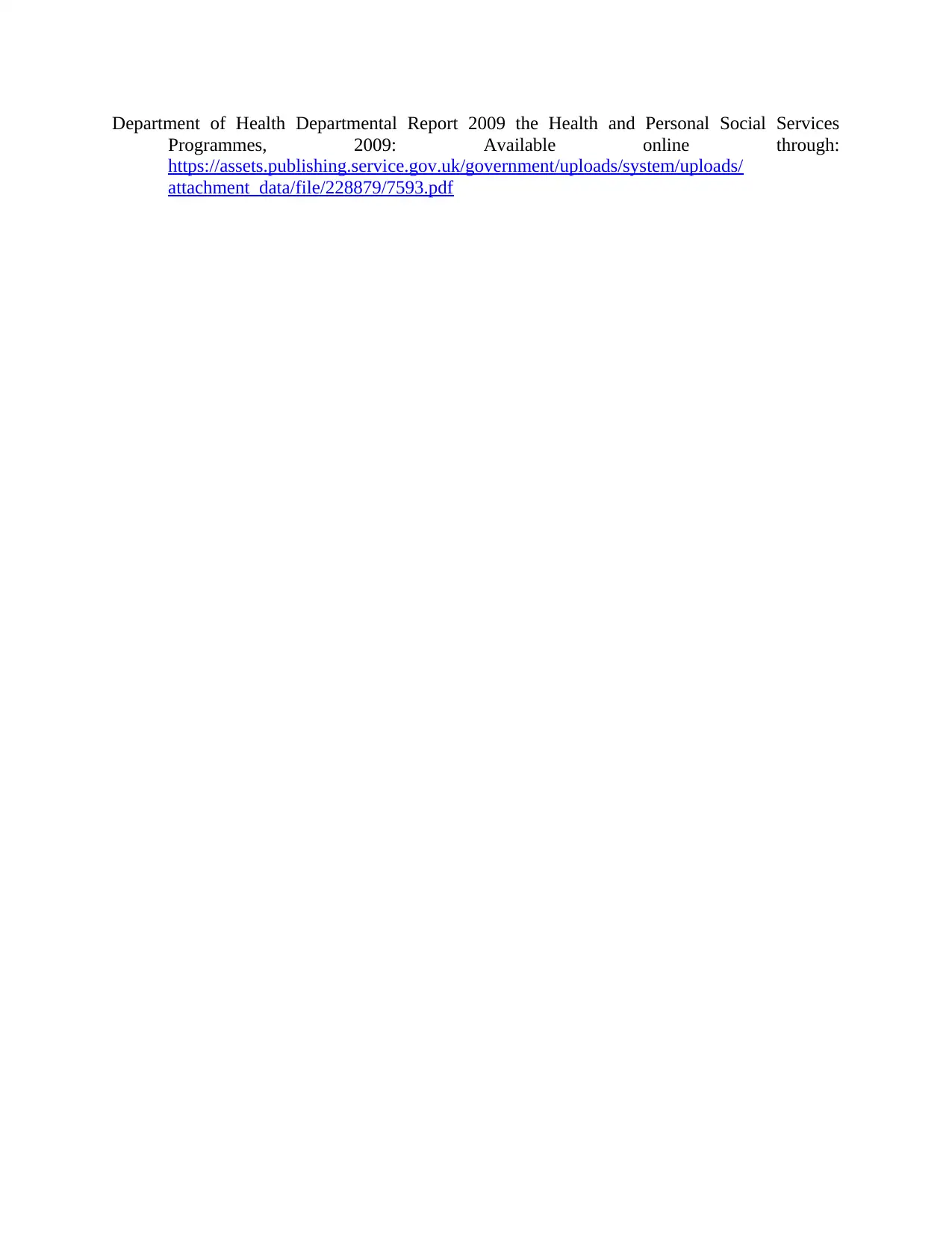
Department of Health Departmental Report 2009 the Health and Personal Social Services
Programmes, 2009: Available online through:
https://assets.publishing.service.gov.uk/government/uploads/system/uploads/
attachment_data/file/228879/7593.pdf
Programmes, 2009: Available online through:
https://assets.publishing.service.gov.uk/government/uploads/system/uploads/
attachment_data/file/228879/7593.pdf
⊘ This is a preview!⊘
Do you want full access?
Subscribe today to unlock all pages.

Trusted by 1+ million students worldwide
1 out of 12
Related Documents
Your All-in-One AI-Powered Toolkit for Academic Success.
+13062052269
info@desklib.com
Available 24*7 on WhatsApp / Email
![[object Object]](/_next/static/media/star-bottom.7253800d.svg)
Unlock your academic potential
Copyright © 2020–2025 A2Z Services. All Rights Reserved. Developed and managed by ZUCOL.




